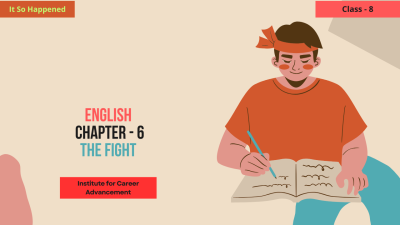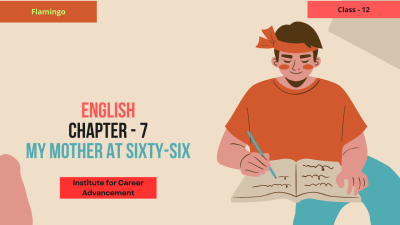Course description
"The Fight"
1. Story Summary:
In "The Fight", the narrative centers on two men who engage in a physical altercation in the public square. The fight is initiated over an argument that seems trivial at first, but the reasons for the conflict are deeper. As the story unfolds, it highlights how human pride, ego, and misunderstandings can escalate into violence.
The fight is intense and dramatic, but in a twist of irony, the two men realize that the conflict is not as serious as they initially thought. They are both deeply embarrassed by the situation, reflecting on how their egos led them to act impulsively. The story ends on a note of self-awareness, leaving the readers to reflect on how easily emotions can be manipulated and how pride can cloud one's judgment.
2. Themes:
Pride and Ego: The main theme revolves around how pride and ego influence human behavior. The men in the story are quick to defend their honor, which leads to unnecessary aggression.
Misunderstanding and Conflict: The fight arises from a small misunderstanding, demonstrating how conflicts often stem from miscommunication or assumptions.
Irony of Human Nature: The ending reveals the irony in the men's actions, as they realize how trivial the fight was in retrospect. This highlights the human tendency to overreact and the regret that often follows impulsive decisions.
Self-awareness and Reflection: After the fight, both men reflect on their behavior, realizing the futility of their actions. This theme encourages introspection and learning from one's mistakes.
3. Key Characters:
The Two Men: The main characters are the two men who engage in the physical fight. While they seem to be enemies at first, their actions reveal deeper aspects of their personalities, such as pride, impulsiveness, and regret.
The Bystanders: The crowd of onlookers serves as a silent commentary on human nature. They witness the fight and its resolution, which indirectly highlights the absurdity of the situation.
4. Key Events:
The Initial Argument: The two men argue, which leads to the fight. The exact cause of the argument is not significant, but it triggers a violent reaction.
The Fight: The altercation escalates in a public space, demonstrating how small misunderstandings can quickly turn into major confrontations.
The Realization: After the fight ends, both men realize how pointless their actions were. This moment of self-awareness is crucial to understanding the story's message.
5. Lessons and Morals:
The Dangers of Pride: The story teaches that unchecked pride and ego can lead to unnecessary conflict and even violence. It is important to control these emotions.
The Importance of Communication: Misunderstandings can be avoided if people take the time to communicate more effectively and not jump to conclusions.
Reflection and Growth: The ending suggests that self-reflection is important. After a conflict, one should step back, assess the situation, and learn from the experience rather than continuing in anger or regret.
Learning Outcomes:
By the end of the lesson, students will be able to:
Summarize the Plot: Retell the events of the story, explaining the main conflict, its escalation, and resolution.
Identify Themes: Recognize and discuss the main themes of pride, ego, misunderstanding, and self-reflection.
Analyze Characters: Understand the motivations of the characters, especially how their pride led them to conflict and later regret.
Connect to Real Life: Relate the lessons of the story to their own experiences with conflict, misunderstanding, or pride.
Appreciate the Story’s Irony: Understand the irony in the story's ending and how it reflects the foolishness of the fight.
Enhance Writing and Communication Skills: Express their ideas clearly in writing or speaking, using examples from the story to support their viewpoints.
"দ্য ফাইট"
1টি। গল্পের সারসংক্ষেপঃ "দ্য ফাইট"-এ, আখ্যানটি দুই ব্যক্তিকে কেন্দ্র করে যারা পাবলিক স্কোয়ারে শারীরিক বিবাদে লিপ্ত হয়। লড়াইটি এমন একটি তর্কের উপর শুরু হয় যা প্রথমে তুচ্ছ বলে মনে হয়, তবে দ্বন্দ্বের কারণগুলি আরও গভীর। গল্পটি প্রকাশিত হওয়ার সাথে সাথে এটি তুলে ধরে যে কীভাবে মানুষের অহংকার, অহংকার এবং ভুল বোঝাবুঝি সহিংসতায় পরিণত হতে পারে।
লড়াইটি তীব্র এবং নাটকীয়, কিন্তু বিদ্রূপের মোড়কে, দুই ব্যক্তি বুঝতে পারে যে দ্বন্দ্বটি ততটা গুরুতর নয় যতটা তারা প্রাথমিকভাবে ভেবেছিল। তারা দুজনেই এই পরিস্থিতিতে গভীরভাবে বিব্রত, তাদের অহংকার কীভাবে তাদের আবেগপ্রবণ আচরণ করতে পরিচালিত করেছিল তা প্রতিফলিত করে। গল্পটি আত্ম-সচেতনতার একটি নোটের উপর শেষ হয়, পাঠকদের প্রতিবিম্বিত করতে দেয় যে আবেগকে কতটা সহজেই পরিচালনা করা যায় এবং কীভাবে গর্ব একজনের বিচারকে মেঘ করতে পারে।
2. থিমঃ গর্ব এবং অহংকারঃ মূল থিমটি কীভাবে গর্ব এবং অহংকার মানুষের আচরণকে প্রভাবিত করে তার চারপাশে ঘোরে। গল্পের পুরুষরা দ্রুত তাদের সম্মান রক্ষা করে, যা অপ্রয়োজনীয় আগ্রাসনের দিকে পরিচালিত করে।
ভুল বোঝাবুঝি এবং দ্বন্দ্বঃ লড়াইটি একটি ছোট ভুল বোঝাবুঝি থেকে উদ্ভূত হয়, যা দেখায় যে কীভাবে দ্বন্দ্ব প্রায়শই ভুল যোগাযোগ বা অনুমান থেকে উদ্ভূত হয়।
মানব প্রকৃতির বিদ্রুপঃ শেষটি পুরুষদের ক্রিয়াকলাপের বিদ্রূপ প্রকাশ করে, কারণ তারা বুঝতে পারে যে পশ্চাদপসরণের ক্ষেত্রে লড়াইটি কতটা তুচ্ছ ছিল। এটি মানুষের অতিরিক্ত প্রতিক্রিয়া দেখানোর প্রবণতা এবং প্রায়শই আবেগপ্রবণ সিদ্ধান্তের পরে অনুশোচনাকে তুলে ধরে।
আত্ম-সচেতনতা এবং প্রতিফলনঃ লড়াইয়ের পরে, উভয় পুরুষই তাদের আচরণের প্রতিফলন করে, তাদের কর্মের নিরর্থকতা উপলব্ধি করে। এই থিমটি আত্মপরীক্ষা এবং নিজের ভুল থেকে শেখার জন্য উৎসাহিত করে।
3. মূল চরিত্রসমূহঃ
দ্য টু মেনঃ প্রধান চরিত্রগুলি হল দুই পুরুষ যারা শারীরিক লড়াইয়ে লিপ্ত হয়। যদিও প্রথমে তাদের শত্রু বলে মনে হয়, তাদের কাজগুলি গর্ব, আবেগপ্রবণতা এবং অনুশোচনার মতো তাদের ব্যক্তিত্বের গভীর দিকগুলি প্রকাশ করে।
দর্শকঃ দর্শকদের ভিড় মানব প্রকৃতির উপর একটি নীরব ভাষ্য হিসাবে কাজ করে। তারা লড়াই এবং এর সমাধান প্রত্যক্ষ করে, যা পরোক্ষভাবে পরিস্থিতির অযৌক্তিকতাকে তুলে ধরে।
4. মূল ঘটনাঃ প্রাথমিক যুক্তিঃ দুই ব্যক্তি তর্ক করে, যা লড়াইয়ের দিকে পরিচালিত করে। যুক্তির সঠিক কারণটি তাৎপর্যপূর্ণ নয়, তবে এটি একটি হিংসাত্মক প্রতিক্রিয়া সৃষ্টি করে।
লড়াইঃ একটি সর্বজনীন স্থানে বিতর্ক বৃদ্ধি পায়, যা দেখায় যে কীভাবে ছোট ভুল বোঝাবুঝি দ্রুত বড় সংঘর্ষে পরিণত হতে পারে।
উপলব্ধিঃ লড়াই শেষ হওয়ার পরে, দুজনেই বুঝতে পারে যে তাদের কাজগুলি কতটা অর্থহীন ছিল। গল্পের বার্তা বোঝার জন্য আত্ম-সচেতনতার এই মুহূর্তটি অত্যন্ত গুরুত্বপূর্ণ।
5. শিক্ষা ও নৈতিকতাঃ
গর্বের বিপদঃ গল্পটি শিক্ষা দেয় যে অনিয়ন্ত্রিত গর্ব এবং অহংকার অপ্রয়োজনীয় দ্বন্দ্ব এবং এমনকি সহিংসতার দিকে নিয়ে যেতে পারে। এই আবেগগুলিকে নিয়ন্ত্রণ করা গুরুত্বপূর্ণ।
যোগাযোগের গুরুত্বঃ ভুল বোঝাবুঝি এড়ানো যেতে পারে যদি লোকেরা আরও কার্যকরভাবে যোগাযোগ করার জন্য সময় নেয় এবং সিদ্ধান্তে না আসে।
প্রতিফলন এবং বৃদ্ধিঃ সমাপ্তি ইঙ্গিত দেয় যে আত্ম-প্রতিফলন গুরুত্বপূর্ণ। একটি দ্বন্দ্বের পরে, রাগ বা অনুশোচনা চালিয়ে যাওয়ার পরিবর্তে পিছু হটতে হবে, পরিস্থিতি মূল্যায়ন করতে হবে এবং অভিজ্ঞতা থেকে শিখতে হবে।
শেখার ফলাফলঃ
পাঠের শেষে, শিক্ষার্থীরা সক্ষম হবেঃ
প্লটটির সারসংক্ষেপ করুনঃ মূল দ্বন্দ্ব, এর বৃদ্ধি এবং সমাধান ব্যাখ্যা করে গল্পের ঘটনাগুলি পুনরায় বলুন।
থিমগুলি চিহ্নিত করুনঃ গর্ব, অহংকার, ভুল বোঝাবুঝি এবং আত্ম-প্রতিফলনের মূল বিষয়গুলি চিনুন এবং আলোচনা করুন।
অক্ষর বিশ্লেষণ করুনঃ চরিত্রগুলির অনুপ্রেরণাগুলি বুঝুন, বিশেষত কীভাবে তাদের গর্ব তাদের দ্বন্দ্ব এবং পরে অনুশোচনার দিকে পরিচালিত করেছিল।
বাস্তব জীবনের সঙ্গে যুক্ত হোনঃ গল্পের পাঠগুলি দ্বন্দ্ব, ভুল বোঝাবুঝি বা গর্বের সাথে তাদের নিজস্ব অভিজ্ঞতার সাথে সম্পর্কিত করুন।
গল্পের বিদ্রূপের প্রশংসা করুনঃ গল্পের শেষের বিদ্রূপ এবং এটি কীভাবে লড়াইয়ের বোকামিকে প্রতিফলিত করে তা বুঝুন।
লেখা এবং যোগাযোগ দক্ষতা বৃদ্ধি করুনঃ তাদের দৃষ্টিভঙ্গিকে সমর্থন করার জন্য গল্প থেকে উদাহরণ ব্যবহার করে লিখিত বা কথা বলার সময় তাদের ধারণাগুলি স্পষ্টভাবে প্রকাশ করুন।



















